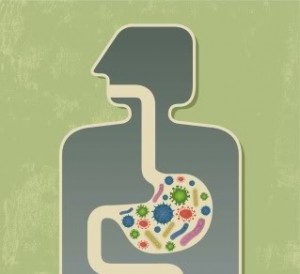Prebiotics and Probiotics
 Research shows the “gut” does more than just process food and fluids. We have zillions of microorganisms living and thriving in our bodies which help defend against infections. To make sure your immune system can cope with the stresses of everyday life you need a healthy level of probiotics and prebiotics in your body.
Research shows the “gut” does more than just process food and fluids. We have zillions of microorganisms living and thriving in our bodies which help defend against infections. To make sure your immune system can cope with the stresses of everyday life you need a healthy level of probiotics and prebiotics in your body.
After the age of 2, your gut flora becomes static. The bacteria that has been living within you from birth is now part of your genetic make-up and cannot be changed. There are over 10,000 unique species of good bacteria in our digestive system. Each of us has a unique number of bacteria that are as distinctive as a fingerprint.
What is a probiotic – The World Health Organization defines probiotics as “live microorganisms, which, when administered in adequate amounts, confer a health benefit on the host.”
Probiotics are found in fermented foods such as yogurts (with live, active cultures), sauerkraut, and pickles. Fermentation is the process of adding yeast to a food to change its structure, by breaking down sugars and starches.
Foods containing high amounts of probiotic include:
- Yogurt (with live cultures)
- Kimchi (a spicy fermented cabbage)
- Dark chocolate
- Pickles
- Some soft cheeses (such as Gouda)
- Sourdough bread
- Fruits such as bananas and tomatoes
- Vegetables like artichokes, green beans, leeks
- Whole-grain breads
- Honey
Most probiotics are destroyed by our stomach acid. Only a fraction, about 1% makes it to the intestines to grow. So a good rule of thumb is to choose a probiotic with the largest number of different organisms and the largest number of total organisms (bacteria or CFUs, probiotics are measured in CFU’s – colony forming units)
- 10 different organisms, 40 Billion CFU
- 10 different organisms, 200 Billion CFU
- 8 different organisms, 450 billion bacteria
- 8 different organisms, 900 billion bacteria
One of the most popular ways to introduce probiotics to your diet is by eating yogurt. It’s the live bacteria in the food you eat that make it full of healthy probiotics. Since heat destroys the bacteria, make sure the label on the yogurt says live or active cultures. Most yogurts are pasteurized, which kills the bacteria. Those yogurts with live cultures add them back in after the pasteurization process.
What is a prebiotic – Prebiotics are “the food” for probiotics. Taking prebiotics helps probiotics work more efficiently and stimulate the growth of bacteria. Prebiotics are found in fruits, vegetables, such as garlic, leeks, onions, and bananas.
How are these bacteria identified? The genus is the first word in a bacterium’s name; it’s the large group to which the bacteria belongs. The species is the type of individual bacteria. Some bacteria have several strains, or differentiations of the species, and this is identified by the last part of the name. Here are a couple examples of common bacteria:
- Lactobacillus bulgaricus can be found in many yogurts and soft cheeses. It helps to convert lactose and other sugars into lactic acid.
- Streptococcus thermophilus is a friendly bacteria are also used to make yogurts and cheeses.
- Lactobacillus acidophilus helps convert lactose into lactic acid
- Bifidobacteria is a family of bacteria that help prevent and treat various gastrointestinal disorders and infections.
Our health depends on factors such as what we eat and drink, how much stress is in our daily lives, and how much activity and exercise we get; taking prebiotics and probiotics will help keep our intestines healthy and help maintain our immune system.


Trackbacks & Pingbacks
Culture Foods/ Probiotics – Eat a bowl of yogurt that contains live probiotic culture. Probiotics are live bacteria that can ease your tummy
Leave a Reply
Want to join the discussion?Feel free to contribute!